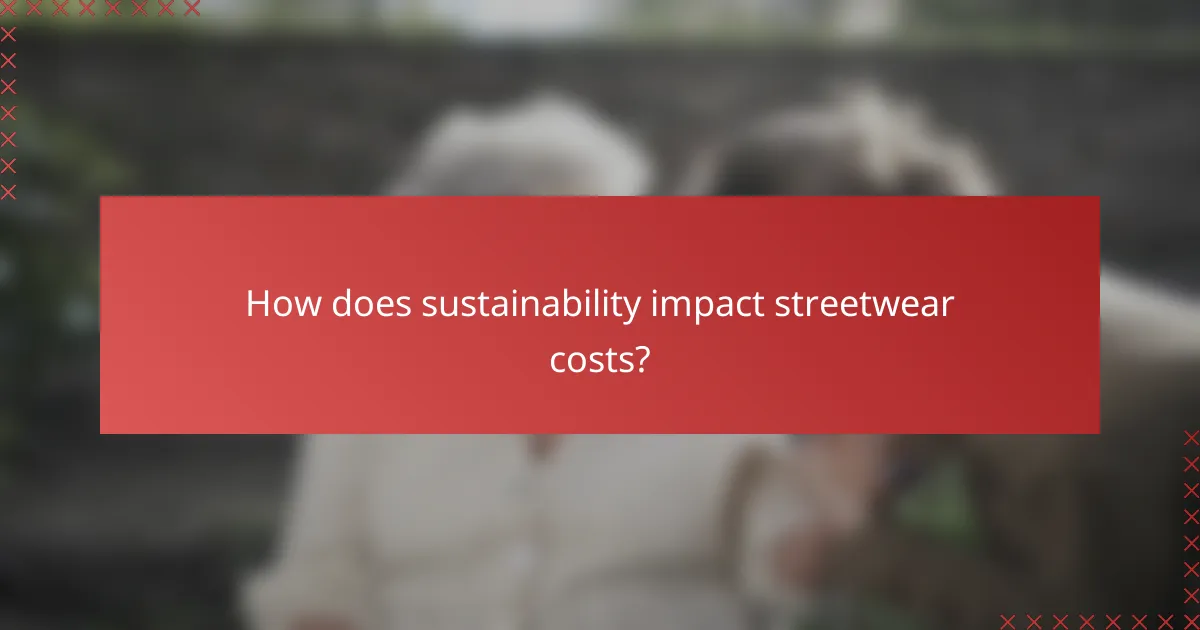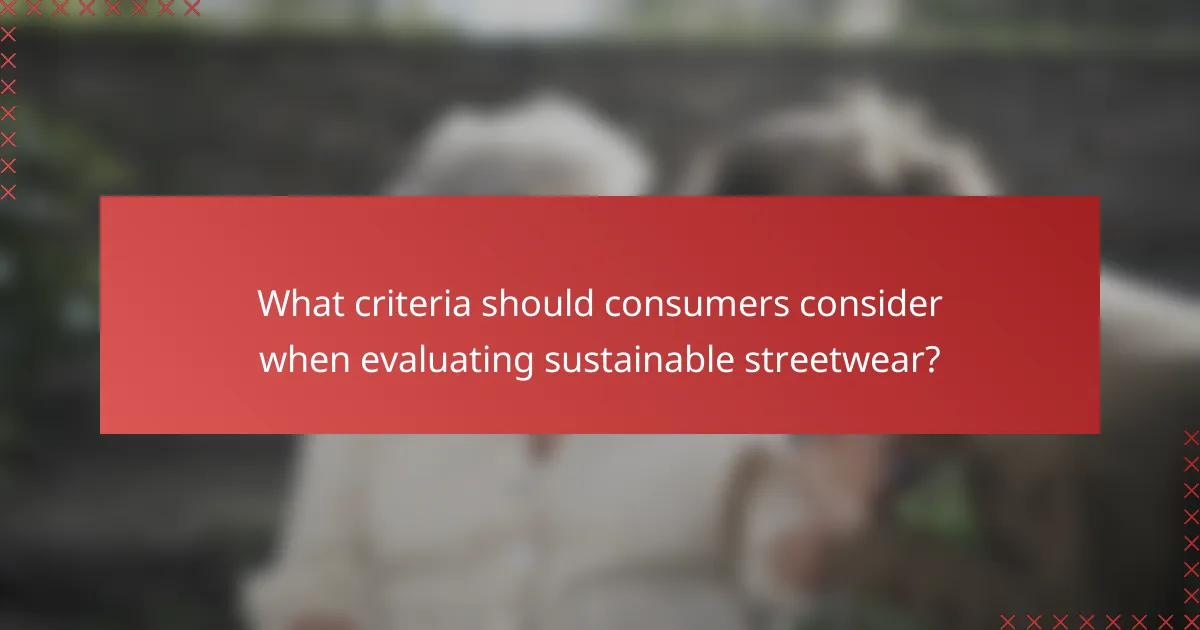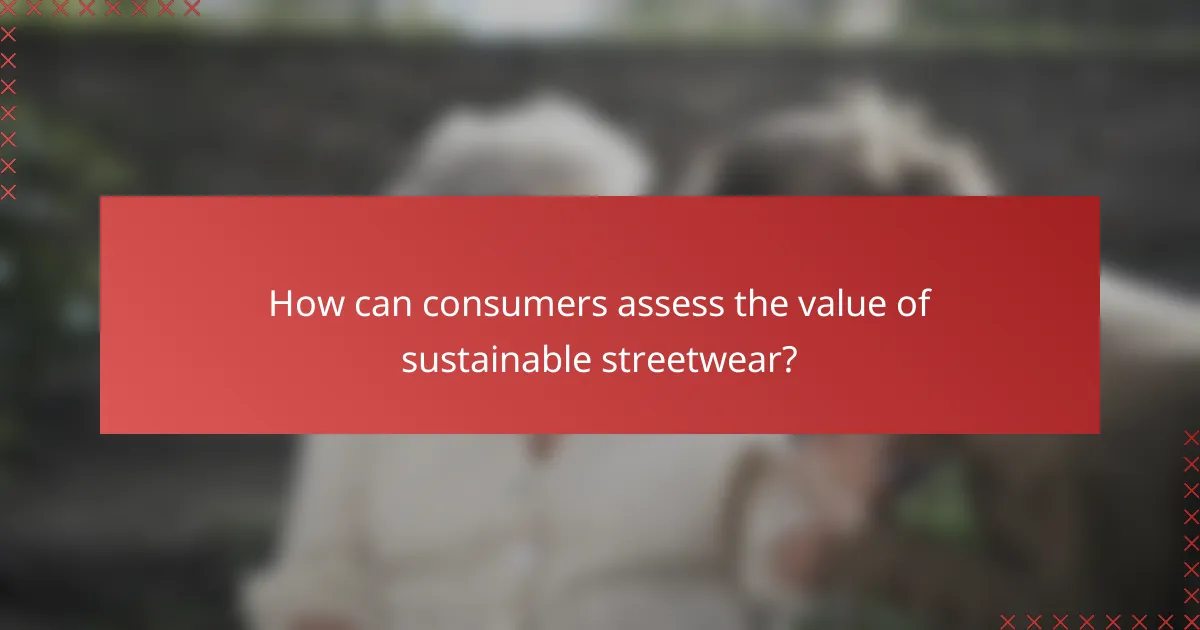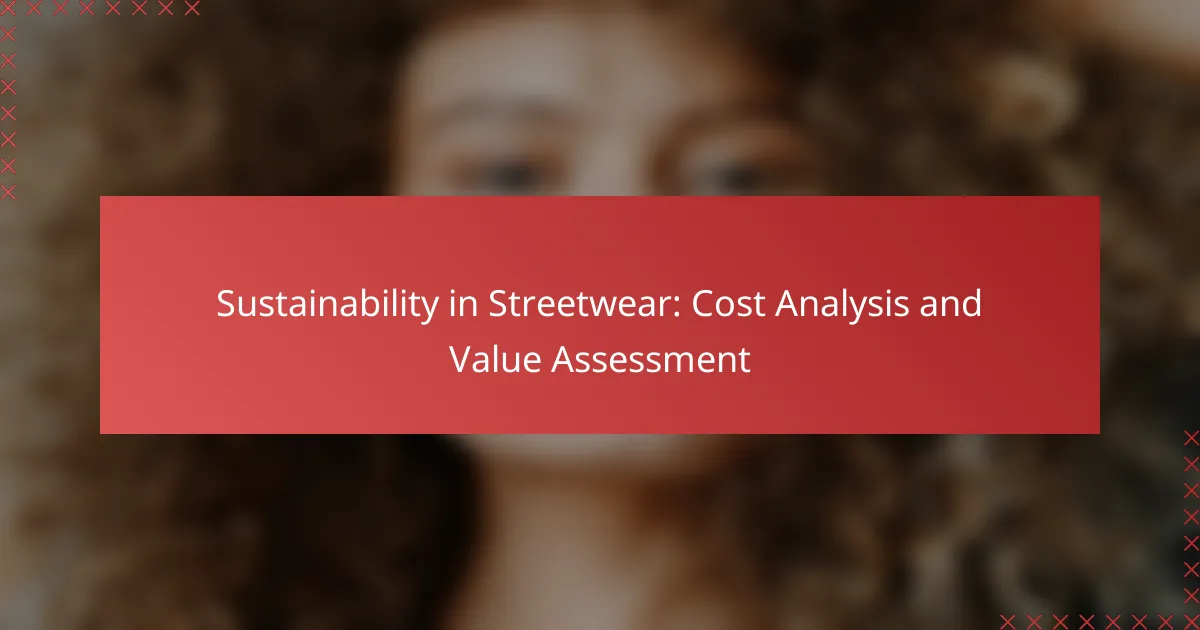The intersection of sustainability and streetwear presents a complex cost analysis that reveals both challenges and opportunities for brands. While the adoption of eco-friendly materials and ethical production methods often leads to increased expenses, these investments can foster long-term consumer loyalty and enhance brand reputation. As the demand for sustainable fashion grows, streetwear brands are increasingly prioritizing environmentally responsible practices to attract conscious consumers and reduce their ecological footprint.

How does sustainability impact streetwear costs?
Sustainability significantly influences streetwear costs by increasing expenses related to materials, production, and logistics. Brands often face higher upfront costs but can benefit from long-term value through consumer loyalty and brand reputation.
Material sourcing expenses
Material sourcing for sustainable streetwear typically involves higher costs due to the use of organic, recycled, or ethically sourced fabrics. For example, organic cotton can cost 20-30% more than conventional cotton, while recycled polyester may also carry a premium. Brands must weigh these costs against the potential for attracting environmentally conscious consumers.
Additionally, sourcing materials locally can further increase expenses but may reduce the carbon footprint associated with transportation. Brands should consider the trade-offs between cost and sustainability when selecting their materials.
Production process costs
The production process for sustainable streetwear often requires more labor-intensive methods and adherence to ethical labor practices, which can raise costs. For instance, factories that comply with fair trade standards may charge higher rates than those that do not. Brands must ensure that their production processes align with sustainability goals while managing these costs.
Investing in cleaner technologies and processes can also lead to higher initial expenses. However, these investments may result in long-term savings through reduced waste and energy consumption, making them worthwhile for brands committed to sustainability.
Shipping and logistics considerations
Sustainable streetwear brands often face increased shipping and logistics costs due to the need for eco-friendly packaging and carbon-neutral shipping options. Utilizing biodegradable materials for packaging can add to expenses, but it enhances brand image and appeals to eco-conscious consumers.
Moreover, sourcing materials and manufacturing locally can mitigate shipping costs and emissions. Brands should evaluate their logistics strategies to find a balance between sustainability and cost-effectiveness.
Brand pricing strategies
To offset the higher costs associated with sustainable practices, many streetwear brands adopt premium pricing strategies. This can involve setting prices that reflect the quality and ethical considerations of their products, often resulting in a price point that is 10-50% higher than conventional alternatives.
Brands must communicate the value of sustainability to consumers effectively, emphasizing the benefits of their eco-friendly practices. Educating customers about the impact of their purchasing decisions can help justify higher prices and foster brand loyalty.

What are the benefits of sustainable streetwear?
Sustainable streetwear offers numerous advantages, including reduced environmental harm and enhanced brand loyalty. By adopting eco-friendly practices, brands can attract conscious consumers while contributing positively to the planet.
Environmental impact reduction
Sustainable streetwear significantly lowers the environmental footprint associated with clothing production. This includes using organic materials, reducing water consumption, and minimizing waste through recycling and upcycling practices.
For instance, brands that utilize organic cotton or recycled polyester can cut down on harmful pesticide use and energy consumption. By choosing sustainable fabrics, streetwear labels can help mitigate climate change and preserve natural resources.
Consumer loyalty and brand reputation
Brands that prioritize sustainability often enjoy increased consumer loyalty and a stronger reputation. Many shoppers today are willing to pay a premium for products that align with their values, particularly those related to environmental stewardship.
Building a reputation for sustainability can differentiate a brand in a crowded market. Engaging in transparent practices and sharing sustainability efforts can foster trust and encourage repeat purchases from eco-conscious consumers.
Long-term cost savings
Investing in sustainable practices can lead to long-term cost savings for streetwear brands. While initial costs may be higher for sustainable materials and production methods, these investments often result in lower operational costs over time.
For example, using energy-efficient manufacturing processes can reduce utility bills, while durable materials can decrease the frequency of replacements. Brands may also benefit from fewer regulatory fines as sustainability regulations become stricter globally.

How do major brands approach sustainability in streetwear?
Major brands in the streetwear industry adopt various strategies to enhance sustainability, focusing on eco-friendly materials, ethical production processes, and waste reduction. These initiatives not only aim to minimize environmental impact but also resonate with increasingly conscious consumers.
Patagonia’s eco-friendly initiatives
Patagonia is a pioneer in sustainable practices within the streetwear sector, emphasizing the use of recycled materials and organic cotton in its products. The brand is known for its commitment to transparency, providing detailed information about its supply chain and environmental impact.
Additionally, Patagonia encourages customers to repair and recycle their clothing through programs like Worn Wear, which promotes a circular economy. This approach not only reduces waste but also fosters a culture of sustainability among consumers.
Nike’s Move to Zero campaign
Nike’s Move to Zero campaign aims for zero carbon and zero waste across its operations. The initiative focuses on using sustainable materials, such as recycled polyester and cotton, to create its streetwear lines. Nike also invests in renewable energy sources for its manufacturing facilities.
As part of this campaign, Nike has launched products like the Space Hippie collection, which features footwear made from factory waste and recycled materials. This not only highlights the brand’s commitment to sustainability but also appeals to environmentally conscious consumers.
Adidas’ Parley for the Oceans collaboration
Adidas collaborates with Parley for the Oceans to create streetwear made from ocean plastic waste. This partnership aims to raise awareness about marine pollution while providing stylish and functional products. The collection includes shoes and apparel that incorporate recycled materials, showcasing a commitment to environmental responsibility.
Through this collaboration, Adidas has produced millions of pairs of shoes using ocean plastic, significantly reducing the amount of waste entering the oceans. This initiative not only addresses environmental issues but also positions Adidas as a leader in sustainable streetwear.

What criteria should consumers consider when evaluating sustainable streetwear?
Consumers should focus on material transparency, labor practices, and life cycle assessments when evaluating sustainable streetwear. These criteria help determine the environmental and social impact of clothing, guiding informed purchasing decisions.
Material transparency
Material transparency refers to the clarity brands provide about the origins and composition of their fabrics. Look for labels that specify the materials used, such as organic cotton, recycled polyester, or Tencel, which are generally more sustainable options.
Brands that disclose their supply chain practices and sourcing methods often demonstrate a commitment to sustainability. A good practice is to check if the company provides certifications, such as Global Organic Textile Standard (GOTS) or OEKO-TEX, which can indicate higher environmental standards.
Labor practices and ethical manufacturing
Ethical manufacturing involves fair labor practices, including safe working conditions, fair wages, and respect for workers’ rights. Consumers should seek brands that are transparent about their labor practices and can provide information on their factories and working conditions.
Look for certifications like Fair Trade or membership in organizations that promote ethical labor standards. Brands that engage in social responsibility initiatives often reflect a commitment to both sustainability and ethical practices.
Life cycle assessment
A life cycle assessment (LCA) evaluates the environmental impact of a product from production to disposal. This includes resource extraction, manufacturing, transportation, usage, and end-of-life disposal. Understanding a brand’s LCA can help consumers gauge its overall sustainability.
When assessing streetwear, consider how long the clothing is designed to last and whether it can be recycled or repurposed. Brands that promote durability and offer take-back programs for recycling are often more sustainable choices.

How can consumers assess the value of sustainable streetwear?
Consumers can assess the value of sustainable streetwear by evaluating its longevity, ethical production practices, and overall cost-effectiveness. Understanding how these factors contribute to the total value helps in making informed purchasing decisions.
Cost per wear analysis
Cost per wear analysis involves calculating the price of a clothing item divided by the number of times it is expected to be worn. This method helps consumers determine the true value of a piece, especially when considering higher upfront costs for sustainable options.
For example, if a sustainable jacket costs $200 and is expected to be worn 100 times, the cost per wear is $2. In contrast, a fast-fashion jacket priced at $50 might only last for 20 wears, resulting in a cost per wear of $2.50. This analysis highlights that investing in sustainable clothing can be more economical in the long run.
To effectively perform a cost per wear analysis, consider the quality, durability, and versatility of the item. Aim for pieces that can be styled in multiple ways or worn across different seasons to maximize usage.
